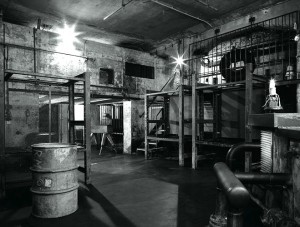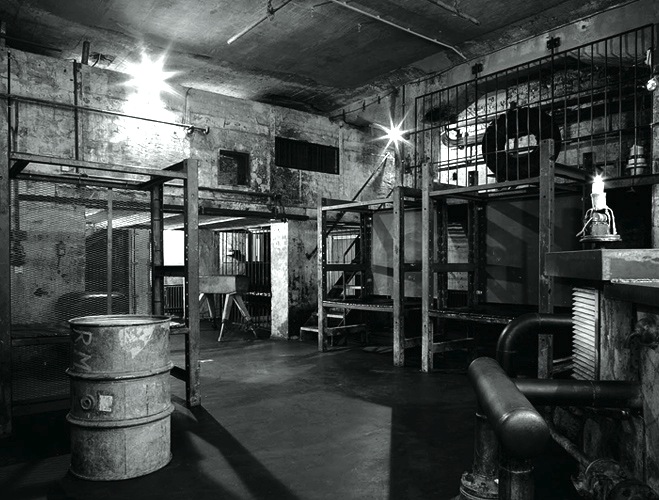FOR YEARS I had heard stories of the fabled sex club, the Lab.oratory, located in an abandoned power station in East Berlin. Described by The Lonely Planet as a well-equipped “lab” with “plenty of toys and rooms for advanced sexual experimentation,” the name of the club alone should give us pause, reminding us that homosexuals were brought to laboratories in Berlin by the Nazis for experimental purposes in the 1930s and ’40s.
Upon entering the Lab.oratory, everyone is given a number that is “branded” on his shoulder with a Sharpie marker, which reminded me of the serial numbers that were tattooed onto the forearms of Holocaust victims by the Nazis. In the club, the numbers are used to keep track of one’s purchases. Still, I wondered whether the Lab.oratory was eroticizing Nazi enslavement and experimentation by using taboo imagery, whether consciously or not. If so, should it be a cause for concern, or does such a place serve as an outlet for a segment of the gay community, offering a way for them to take control of their sexuality after years of shame and discrimination?

As I approached the massive power station that houses the Lab.oratory, I was in awe of the imposing exterior, which exuded all the sterile monumentality of Soviet-era architecture. There was a long dirt path leading to the entrance that was lined with a metal barricade fence held in place by concrete blocks. The Lab.oratory is a part of the Berg-hain in the nightclub section of Berlin. The Berghain is in the main space and primarily plays techno music. Upstairs is the Panorama Bar that focuses on house music, and the Lab.oratory is on the ground level serving as a gay male sex club. The Berghain is one of the most famous techno clubs in all of Europe, though you’d never know it from the outside. It hosts the world’s most influential DJs to a mixed gay and straight crowd of 1,500 patrons. It opened in 2004 as a reincarnation of the Ostgut Club, which was arguably the focal point of Europe’s techno scene in its day. Ostgut hosted a male-only fetish night, “Snax,” six to eight times a year, which is still held twice a year in the Berghain and Lab.oratory and boasts “delicious sodomitical debaucheries.”
The entrance for the Lab.oratory is at the side of the building and there was a long line of men waiting to get in, ranging from young hipsters to papa bears, from tourists to native Berliners. It truly was an inclusive environment. They let people in from 10 p.m. to midnight, at which point the doors are locked for the rest of the night. Theme nights alternate from week to week. The theme for my evening was Friday Fuck 2-4-1. Other themes include Yellow Facts Beer Burst, Filthy Farm, and, for the holidays, X-MAS Fausthouse. Upon entering I was marked with the number 267 and given a white trash bag for my clothes, money, and phone, like an inmate being checked into jail. A friend told me that you have to take off at least one article of clothing. Nobody seemed to be enforcing this rule, but I removed my shirt so as not to stand out; some men were completely naked. While I waited to check my bag, I watched one guy model his outfit for a friend: he was wearing a leather harness with a military side cap and Speedo. He had brought a large sports bag to carry his costume in, and offered his extra gear to his friend while accessorizing. It reminded me of the first day of school as a kid when I’d debut my back-to-school clothes and my new backpack. I entered the main room and ordered a beer at the bar, flashing the number on my shoulder. I learned that Friday Fuck 2-4-1 was a “2 für 1” drink night. A group of men were having sex near the bar amid a larger crowd of men who were having casual conversations and laughing as they would at any other cocktail lounge. Up above, on the mezzanine, a group of guys were taking turns fucking a guy in a sling. In the distance, beyond the prison bars, was a larger orgy that seemed to encompass dozens of guys. Concerns about safety were nowhere to be found, as bareback sex was rampant. The main bar had a War-era industrial motif with steam piping, pressure gauges, and multiple pipe fittings. The light fixtures lining the bar were made of high voltage power line insulators, resembling those in Dr. Frank- enstein’s laboratory seen in the 1931 film, Frankenstein. Techno music was pounding an aggressive beat, which I found disconcerting. I’ve been a diehard techno fan for most of my adult life, indulging in anything from minimal techno to the more futuristic sound, but the beats in the club were harder, faster, and more industrial than anything I was used to. The beat sounded like two pipes being hit together repeatedly and very rapidly. The “laboratory” theme was somewhat disturbing in that we were in Berlin, where homosexuals in concentration camps had been subjected to scientific experimentation by the Nazis, who were attempting to find a “cure” for homosexuality. A Danish physician at the Buchenwald concentration camp, Dr. Carl Vaernet, did extensive experimentation on gay men by injecting them with high doses of male hormones, which were thought to be deficient in gay men. The goal was to explore whether these subjects could be caused to be attracted to the opposite sex after such a procedure, but the results remain unknown, as a yellow fever epidemic in the camp ended the experiment. Whether the owners of the Berghain, Michael Teufele and Norbert Thormann, are aware of the Nazi references is hard to say. They rarely give interviews (I tried, with no luck), and it doesn’t appear that they’ve ever addressed this question. The official ban on Nazi displays of any kind in modern Germany is such that they probably wouldn’t admit to a deliberate connection in any case. At the same time, perhaps it was inevitable that someone would venture into this forbidden territory, precisely because it is so verboten. Such is the nature of BDSM as an expression of sexual desire and practice, at least on the fringes of this community: the quest for novelty. It is a sexual subculture that’s built on fantasy and enacted in metaphorical spaces—prisons, the military, dungeons, torture chambers—with play acting limited only by the participants’ imaginations. That this is happening in Germany and in Berlin might be disturbing in light of the not-so-distant past that’s being evoked. On the other hand, it is precisely this geographic feature that gives the metaphorical “laboratory” its power to terrify and arouse. As fantasies go, the Nazi era provides a ready landscape for the creation of a metaphorical space that goes beyond the standard prison bars and physical restraints, creating an experience of the forbidden that’s authentically subversive. This geographic and historical element is one of which most Germans, and even some international visitors, are at least vaguely aware. While Berlin was one of the most open and tolerant cities in the 1920s and early ’30s, from 1933 to 1945 an estimated 100,000 men were arrested for homosexual behavior, 50,000 of whom were sentenced and served time in prison, where they were subjected to humiliating treatment. It is estimated that some 5,000 to 15,000 were sent to concentration camps. In these camps, homosexuals were forced to sleep with their hands outside of the covers, and if any were found with their hands under the sheets, or without underwear on, they were taken outside and drenched in cold water, even in the winter. Even after the War, Germany and its new allies didn’t acknowledge the mistreatment of homosexual men in the camps. Under the Allied Military government, some gay men were forced to serve out their prison sentences regardless of the time they spent in the concentration camps. The German government offered compensation to victims of the war, but homosexuals were not included in these reparations. Indeed, gay people still faced the possibility of arrest and incarceration at this time. It wasn’t until 1969 that West Germany decriminalized homosexuality, and not until 2000 that the German government issued an official apology for the persecution of homosexuals by the Third Reich. On May 17, 2002, they were officially pardoned by the German government. Survivors were offered compensation for the treatment they had received during the Holocaust. Justice minister Hertha Daeubler-Gmelin told parliament: “We all know that our decisions today are more than fifty years late, they are necessary nonetheless. We owe it to the victims of wrongful Nazi justice.” An hour after arriving at the Lab.oratory, about a hundred bowls of chocolate pudding came out in the main room, which people started throwing around. Before I knew it I was covered; the sweet smell turned my stomach. Many people escaped into the side rooms, which was perhaps the intention of throwing the pudding in the first place: to facilitate more action. The pudding was followed by the release of thousands of feathers, which adhered to the pudding and produced the effect of being tarred and feathered. Heading to the restroom to clean up, I wondered: is this what liberation looks like? On leaving the restroom, I explored the other part of the clubs and noticed the many cramped halls and spaces that were stuffed with naked bodies. Lighting was minimal, so you could only see shadows and hear moans. I got nervous whenever I came to a dead end, wary of who was behind me, so I would quickly turn and backtrack. In one of the side rooms I witnessed many pairs of men, presumably total strangers, having unprotected anal sex. In another there was a thin man, almost gaunt, with a shaved head sitting in a misplaced bathtub waiting to be urinated on. It would be naïve to suggest that such practices don’t happen all over the world: there are bathhouses, saunas, and fetish parties in other cities that allow people to indulge in extreme fantasies. But for it to happen on such a large scale, in a such peculiar environment, and with such a diverse crowd is what makes the Lab unique. I’d lost track of time: it was 3:30 a.m. when I decided that I wanted to leave the club. The air was thick and stale, smelling of beer, armpits, urine, and other manly aromas. The number on my shoulder had been smeared by the flesh and sweat of other men. I showed the number one last time at the bar to pay up and then joined a long line of people waiting to retrieve their belongings. Once dressed, we all become ordinary people again: the fantasy was over. My jeans were stained with chocolate pudding and my shoes were covered in feathers (and who knows what else?). I was a little overwhelmed by it all, a stranger in a strange land, and wondered how the experience would have been different if I had been born and raised in Germany or specifically in Berlin. It’s hard to tell. Berlin is a city with a tragic past that’s so fresh you can still see where bullet holes in the buildings have been patched over. Whether the Lab had special resonance for Berliners because of this history, whether going there was an act of rebellion or subversion or something else, far be it from me to judge its validity as an expression of sexual freedom and experimentation. James Chaarani’s work has appeared in The Blue Lyra Review, Segue, and Instinct. His first novel will be published by Lethe Press next year.





